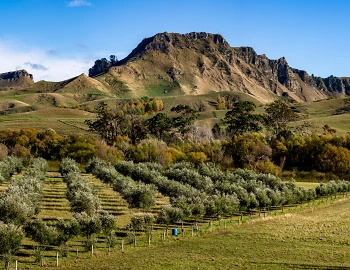Languedoc-Roussillon
Languedoc and Roussillon: the wine-giant of the south
The largest contiguous wine region of France begins on the west bank of the Rhône River, stretching more than 240 kilometres to the west to Banyuls-sur-Mer, on the border with Spain. The area is an inexhaustible reservoir of corpulent wines from international varieties, but the top crus from this region come from various regional appellations, where long-established varieties such as Carignan and Grenache (red) and Picpoul and Bourboulenc (white) yield extraordinarily characterful wines.
White wines from Languedoc-Roussillon
Red wines from Languedoc-Roussillon
Superficially, Languedoc-Roussillon is a huge wine region, in which impressive volumes of crops with strong, fruity fullness and Mediterranean charm grow on more than 250,000 hectares. Upon closer inspection, the area – which is often simply called “Midi” – emerges as a highly complex jigsaw of different appellations producing wines with distinctive character.
The basis for this diversity of wines is the completely distinct soil types. Thus, slate soils shape the wines in Banyuls, Maury, Corbières, Minervois and Saint-Chinian, while gravel debris and limestone soils with crushed stone characterize the terroirs of Rivesaltes, Minervois and the Costières de Nimes Near the coast, on the other hand, alluvial soils dominate. The Mediterranean climate, too, is not nearly as uniform as one might expect. In particular, the vineyards in the interior are affected by the Tramontane – a strong, cool autumn wind which contributes, among others, to the robust structure of the wines of Corbières.
The new range of varieties
At the same time, however, the area is a tremendous source of corpulent everyday wines which often come to market under the Pays d’Oc IGP designation. These wines, produced in vast quantities by large wineries, are often vinified from varieties not typical of the area, such as Cabernet Sauvignon, Chardonnay, Merlot, Sauvignon Blanc, Syrah or Viognier. The term Pays d’Oc alludes to the Occitan language, which is still spoken in this part of France today.
Independent wines
With an average yearly temperature of 14 degrees Celsius, Languedoc-Roussillon is the warmest region in France. Additionally, the average rainfall of 400 millimetres per year per square metre is quite low. Because the vineyards are spread over a vast area, monocultures are the exception. The garrigue, the typical Mediterranean shrub heathland, mainly provides an ecological compensation area. These factors favour the cultivation of natural or organically produced wines. The area produces a whole range of noteworthy specialties: the Blanquette de Limoux is a characterful sparkling wine based on the Mauzac grape; the Picpoul de Pinet grown near the sea yields surprisingly crisp white wines; and appellations such as Minervois, La Clape, Faugères or Saint-Chinian are guarantors of red wines that are full of character.

Region

Hawkes Bay
Hawke’s Bay is located in the east of New Zealand’s North Island and is the country’s oldest and second-largest wine-growing region (approx. 4640 hectares), dating back to 1851. Hawke’s Bay is New Zealand’s largest wine-growing region for high-quality red wines, accounting for over 80 percent of its total production of Cabernet Sauvignon, Merlot and Syrah. Chardonnay and the two varieties Cabernet Sauvignon and Merlot make up around 50 percent of total production at Hawke’s Bay. White and red wines are produced in approximately equal amounts. The region produces a total of 10 percent of all New Zealand wines.




